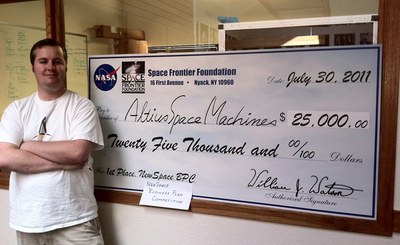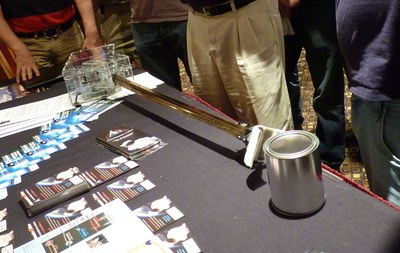The evolving ecosystem of NewSpaceby Jeff Foust
|
| “I haven’t invented warp drive,” Goff said, “but I think I can do a tractor beam.” |
Six months later, after working on miscellaneous contracts for other companies, Goff discussed his company’s new focus in a presentation at the Space Access ’11 conference in Phoenix. “You’d think we’d be doing most of our work on rocket propulsion, rocket vehicles, things like that,” he said. “But it turns out the first product we’ve really gained traction with is actually a rendezvous and docking technology. I didn’t think I was starting a spacecraft mechanisms company, but apparently I did.”
That direction, he said, was driven by the need for improved, simplified docking systems to support the high flight rates envisioned for future RLVs to serve markets like propellant depots. The solution Altius has proposed is what the company calls the “Sticky Boom”: a long, deployable boom that has a special electrostatic adhesion material, developed by SRI International, that allows the boom to attach to almost anything without the need for special manipulators or grapples. “You don’t even have to know what the thing is made of what it’s shaped like before you go to stick to it,” Goff said.
At the time of the Space Access conference, Altius had developed a proof of concept demonstrator: a small boom that extended about a meter with a C-shaped grapple on the end that included the electrostatic adhesion material, allowing it to attach to objects (in this case, a small can) and move them across a table. The demonstration became the hit of the conference, and after Goff’s presentation people surrounded a table in the conference’s exhibit area to see the boom at work.
Nearly four months later Goff was again presenting about Altius, this time as one of the finalists in the NewSpace Business Plan Competition at the NewSpace 2011 conference at NASA Ames Research Center in California. The Sticky Boom technology, advanced over the interim through a series of development “sprints”, including one that concluded with a successful test of the system on a zero-g parabolic aircraft flight, was now at the center of a concept Altius called “Direct to Station” to enable just-in-time deliveries of small cargo to the station.
In the Direct to Station system, a small rocket, such as a dedicated nanosatellite launcher, would launch a cargo spacecraft carrying critical supplies to the station. Rather than docking directly to the station, though, the spacecraft would only approach close enough to be in range of a Sticky Boom system on the ISS. The boom would deploy, attach to the spacecraft, and reel it in. “It allows us to offload the visiting vehicle requirements off the nanosat launch provider and more towards our side of the solution space,” Goff explained in his pitch to the business plan competition’s judges. “It will ultimately allow us to change how space deliveries are done forever.”
This solution, he said, would open up a new market for launch providers as well as for his company, which would generate revenue from leasing the hardware to the station and charging fees to the companies delivering spacecraft to the station. The technology had applications elsewhere, he added, noting interest from NASA and industry for uses ranging from Mars sample return missions to orbital debris removal.
Back at Space Access, Goff recalled that some have argued that it won’t be possible for commercial space activities to go much beyond the status quo without a quantum leap forward in propulsion technology, like the warp drive from Star Trek. “I haven’t invented warp drive,” he said, “but I think I can do a tractor beam.”
Other NewSpace niches
Altius Space Machines is not the only NewSpace company focusing on an enabling technology rather than a complete launch vehicle or spacecraft. At Space Access, Max Vozoff discussed work by Innovative Space Propulsion Systems (ISPS), a company commercializing NOFBX, a new monopropellant based on nitrous oxide intended to replace hydrazine in space applications. NOFBX, Vozoff explained, is more efficient and less expensive than hydrazine and, unlike hydrazine, is non-toxic.
| “The problem for space experimenters currently is that they have to spend as much time building their computers as they do building the experiment itself,” said Celestial Circuits’ Dunstan. |
The challenge Vozoff and ISPS face is trying to demonstrate those advantages. “We are lacking 50 years of flight heritage,” unlike hydrazine, he said. The company is planning to start closing that gap in experience by flying a demonstration of their system on the ISS late next year. If successful, that could unlock an existing market Vozoff conservatively valued at $500 million a year, plus new enabled markets created by this propellant.
Vozoff joined ISPS as its vice president of business development after leaving SpaceX, where he has worked on the Commercial Orbital Transportation Services (COTS) program. “The opportunity to be a founding member of ISP Systems was a significant factor in my decision to leave SpaceX last year,” he said. That opportunity, though, is not without considerable work. “I thought I had a leisurely six to nine months to get our business model together and roll it out in an orderly fashion, and all of a sudden all these big proposals were due the next month.”
At the NewSpace 2011 business plan competition, two of the other four finalists were also focused on products that supported the broader NewSpace industry. Celestial Circuits plans to develop low-cost flight computers for small satellites, including cubesats—tiny spacecraft 10 centimeters on a side and weighing one kilogram that are popular with university programs—that today often have to rely on custom-built solutions. “If I want to conduct a chemistry experiment, the first thing I don’t do is invent the Bunsen burner,” said co-founder Jim Dunstan. “The problem for space experimenters currently is that they have to spend as much time building their computers as they do building the experiment itself.”
Celestial Circuits plans to offer several tiers of computers, from low-end systems designed for educational use in the lab to fully space-qualified radiation-hardened systems for spacecraft, using the volume of demand they anticipate to lower prices below existing options. The company already has a memorandum of understanding with NanoRacks, a company providing small experiment rack space on the ISS, to use its computers. “Celestial Circuits is going to standardize and drive down the costs of computer hardware for the cubesat format,” Dunstan said, “and the same hardware can be used from tower drops, or dropping it off your school if you’re a student, all the way up to the ISS.”
Final Frontier Design, another company in the business plan competition, seeks to enter the market for spacesuits. That area is relatively crowded given the low demand for such products currently: in addition to existing companies like ILC Dover, Hamilton Sundstrand, and Oceaneering that have largely focused on NASA work, Orbital Outfitters has been working on pressure suits for the last several years, targeting NewSpace vehicle developers in particular.
What sets his company apart, said co-founder Ted Southern, is their pressure suit design, which does away with the double-layer pressure garments—an inner pressure bladder and outer restraint layer—common to other suits in favor of a simpler single-layer design that weighs less, is more comfortable, and also costs less. “We see a huge advantage in this technology,” he said. That suit technology has been developed by Southern and his fellow co-founder, Nikolay Moiseev, who spent over 20 years developing spacesuit designs for the Russian space program.
| “To me, a NewSpace company is a company that is built, formed, operated by, funded by, or has as part of its business plan the opening of the space frontier, and making a profit while doing so,” Tumlinson said. |
Southern said his company plans to sell suits directly to vehicle developers, and has been in discussions with Armadillo Aerospace via Space Adventures—who will market suborbital space tourism flights on vehicles Armadillo plans to develop—regarding suits. Each suit would sell for $75,000 and be certified for ten flights; southern added that the cost to develop the suits is “encouragingly cheap.”
At the end of the banquet that capped off the NewSpace 2011 conference two weeks ago, the business plan competition judges announced the winners. Final Frontier Design won third place and a $2,500 prize. Celestial Circuits won second place and $5,000. And Altius Space Machines? Its Sticky Boom reached out and grabbed the $25,000 grand prize.
“Wow,” Goff said in accepting the prize. “We’ve got a lot of work ahead for ourselves.”
 Altius Space Machines CEO Jon Goff poses with the check for winning the grand prize in the NewSpace Business Plan Competition last month. (credit: Altius Space Machines) |
What does NewSpace mean?
This broader scope of companies that fall under the NewSpace umbrella, from developers of inexpensive spacecraft computers to new propellants to booms that make spacecraft rendezvous and docking simpler, raises a fundamental question: what does it mean for a company to be a “NewSpace company”? And, just what exactly is NewSpace, if it’s more than companies building low-cost suborbital and orbital launch systems? Can more established companies working in new commercial fields—think Orbital Sciences in commercial cargo to the ISS and Boeing in commercial crew—be considered part of NewSpace?
“We have some disagreements, back and forth internally, about what NewSpace means,” Space Frontier Foundation co-founder Rick Tumlinson said in a luncheon speech at the NewSpace 2011 conference. NewSpace, in his opinion, is “a way of doing business and NewSpace is an industry doing business in a new way, and NewSpace is an industry that’s doing business for a purpose.”
And what purpose is that? “To me, a NewSpace company is a company that is built, formed, operated by, funded by, or has as part of its business plan the opening of the space frontier, and making a profit while doing so,” he said. “It is the industrial engine that will power the movement” towards a more fundamental goal of space settlement. The definition is certainly broad enough to capture a wide range of entrepreneurial and even established companies doing far more than space tourism and servicing the ISS. Just how lucrative those markets are, though, remains to be seen.
